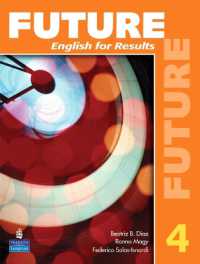- ホーム
- > 洋書
- > 英文書
- > Performing Arts
Full Description
The late 1920s and early 1930s were a pivotal moment in Russian cultural development: a time of uncertainty but also of openness and experimentation in the arts and especially in dance. During this period in Leningrad, Dmitri Shostakovich composed three ballets--The Golden Age, The Bolt, and The Limpid Stream--at a time when he was consolidating his position as Soviet Russia's preeminent young composer. His three ballets aimed at creating Soviet ballet, or works that commanded the technical legacy of the genre but that promoted contemporary topics and Soviet cultural policies. The Limpid Stream proved hugely successful and was even staged as part of the 1935 celebrations for Stalin's birthday at the Bolshoi Theatre in Moscow. Six weeks later, however, the ballet was condemned, just a week after Shostakovich's opera Lady Macbeth suffered a similar fate. Shostakovich never wrote another ballet.
Shostakovich's ballets of the early 1930s occupied a unique moment in Soviet cultural history and in the development of early Soviet dance. As author Laura E. Kennedy demonstrates, cultural policy shifted frequently and rapidly in these years, summoning all areas of Soviet life to new orthodoxies. Like other arts, ballet emerged as a testing ground for the marriage of artistic innovation to Soviet ideology. Kennedy argues that Shostakovich's three ballets shaped the search for a Soviet approach to the genre in offering three distinct responses to these demands. At the same time, they illuminated the pressures and concerns that vied for dominance in the experimental environment of the late 1920s and early 1930s.
Throughout, Kennedy draws on extensive archival materials from St. Petersburg and Moscow--many of which have not previously been published--that preserve the creative record of Shostakovich's ballets in scores, répétiteurs, photographs, libretti, costume sketches, set designs, theatre documents, and annals of performance. Backed by these primary sources, she charts the complex histories of Shostakovich's ballets, their contributions to dance in Russia, and their impact on the composer's artistic career and the genre of ballet in the twentieth century.
Contents
Dedication
Acknowledgements
Note on Names and Transliteration
List of Archives
Preface
Introduction
Chapter 1. "Art without movement does not move me": Shostakovich and the Path to Ballet
Chapter 2. Petipa's Legacy: The Golden Age and Classical Ballet
Chapter 3. Amateur Dramatics: The Bolt and Modern Ballet
Chapter 4. Soviet Sylphs: The Limpid Stream and Romantic Ballet
Chapter 5. Shostakovich and Ballet: Lives and Afterlives
Appendix A: Chart I: The Golden Age, Act I, scene 1 in two scenarios
Appendix B: Librettos
Bibliography
Index






